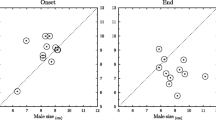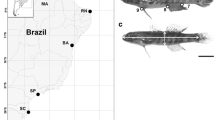Abstract
Sexual selection contributes strongly to the evolution of sexual dimorphism among animal taxa. However, recent comparative analyses have shown that evolution of sexual dimorphism can be influenced by extrinsic factors like mating system and environment, and also that different types of sexual dimorphism may present distinct evolutionary pathways. Investigating the co-variation among different types of sexual dimorphism and their association with environmental factors can therefore provide important information about the mechanisms generating variation in sexual dimorphism among contemporary species. Using phylogenetic comparative analyses comparing 49 species of Tanganyikan cichlid fishes, we first investigated the pairwise relationship between three types of sexual dimorphism [size dimorphism (SSD), colour dimorphism (COD) and shape dimorphism (SHD)] and how they were related to the strength of pre- and post-copulatory sexual selection. We then investigated the influence of ecological features on sexual dimorphism. Our results showed that although SSD was associated with the overall strength of sexual selection it was not related to other types of sexual dimorphism. Also, SSD co-varied with female size and spawning habitat, suggesting a role for female adaptations to spawn in small crevices and shells influencing SSD in this group. Further, COD and SHD were positively associated and both show positive relationships with the strength of sexual selection. Finally, the level of COD and SHD was related to habitat complexity. Our results thus highlight distinct evolutionary pathways for different types of sexual dimorphism and further that ecological factors have influenced the evolution of sexual dimorphism in Tanganyikan cichlid fishes.


Similar content being viewed by others
References
Abouheif E, Fairbairn DJ (1997) A comparative analysis of allometry for sexual size dimorphism: assessing Rensch’s rule. Am Nat 149:540–562
Andersson M (1994) Sexual selection. Princeton University Press, Princeton, NJ
Badyaev AV (1997) Altitudinal variation in sexual dimorphism: a new pattern and alternative hypotheses. Behav Ecol 8:675–690
Badyaev AV, Hill GE (2003) Avian sexual dichromatism in relation to phylogeny and ecology. Annu Rev Ecol Evol Syst 34:27–49
Barlow GW (2000) Cichlid fishes. Nature’s grand experiment in evolution. Perseus Books, Cambridge
Berglund A, Rosenquist G, Svensson I (1986) Mate choice, fecundity and sexual dimorphism in two pipefish species (Syngnathidae). Behav Ecol Sociobiol 19:301–307
Blanckenhorn WU (2000) The evolution of body size: what keeps organisms small? Q Rev Biol 75:385–407
Blanckenhorn WU (2005) Behavioral causes and consequences of sexual size dimorphism. Ethology 111:977–1016
Carleton K (2009) Cichlid fish visual systems: mechanisms of spectral tuning. Int Zool 4:75–86
Cuervo JJ, Møller AP (1999) Ecology and evolution of extravagant feather ornaments. J Evol Biol 12:986–998
Darwin C (1871) The descent of man and selection in relation to sex. John Murray, London
Dobberfuhl AP, Ullmann JFP, Shumway CA (2005) Visual acuity, environmental complexity, and social organization in African cichlid fishes. Behav Neurosci 119:1648–1655
Doucet SM, Mennill DJ (2009) Dynamic sexual dichromatism in an explosively breeding Neotropical toad. Biol Lett 6:63–66
Dunn PO, Whittingham LA, Pitcher TE (2001) Mating system, sperm competition, and the evolution of sexual dimorphism in birds. Evolution 55:161–175
Endler JA (1992) Signals, signal conditions, and the direction of evolution. Am Nat 139:S125–S153
Endler JA (1993) Some general comments on the evolution and design of animal communication systems. Phil Trans R Soc Lond B 340:215–225
Endler JA (2000) Evolutionary implications of the interaction between animal signals and the environment. In: Espmark Y, Amundsen T, Rosenqvist G (eds) Animal signals. Tapir Academic Press, Trondheim, pp 11–46
Endler JA, Théry M (1996) Interacting effects of lek placement, display behavior, ambient light, and colour patterns in three Neotropical forest-dwelling birds. Am Nat 148:421–452
Fairbairn DJ (2007) The enigma of sexual size dimorphism. In: Blackenhorn W, Fairbairn D, Szekely T (eds) Sex, size and gender roles. Oxford University Press, Oxford, pp 27–37
Fairbairn DJ, Blanckenhorn WU, Székely T (eds) (2007) Sex, size and gender roles: evolutionary studies of sexual size dimorphism. Oxford University Press, New York
Figuerola J, Green AJ (2000) The evolution of sexual dimorphism in relation to mating patterns, cavity nesting, insularity and sympatry in the Anseriformes. Funct Ecol 14:701–710
Fitzpatrick JL, Montgomerie RM, Desjardins JK, Stiver KA, Kolm N, Balshine S (2009) Female promiscuity promotes the evolution of faster sperm in cichlid fishes. Proc Natl Acad Sci USA 106:1128–1132
Freckleton RP, Harvey PH, Pagel M (2002) Phylogenetic analysis and comparative data: a test and review of evidence. Am Nat 160:712–726
Froese R, Pauly D (2010) FishBase. World Wide Web electronic publication. www.fishbase.org, version (11/2010)
Gonzalez-Voyer A, Kolm N (2010) Sex, ecology and the brain: evolutionary correlates of brain structure volumes in Tanganyikan cichlids. PLoS ONE 5(12):e14355
Gonzalez-Voyer A, Fitzpatrick JL, Kolm N (2008) Sexual selection determines parental care patterns in cichlid fishes. Evolution 62:2015–2026
Gonzalez-Voyer A, Winberg S, Kolm N (2009) Social fishes and single mothers: brain evolution in African cichlids. Proc R Soc Lond B 276:161–167
Grafen A (1989) The phylogenetic regression. Phil Trans R Soc Lond B 326:119–157
Hert E (1989) The function of egg-spots in an African mouth-brooding cichlid fish. Anim Behav 37:726–732
Höglund J (1989) Size and plumage dimorphism in lek-breeding birds: a comparative analysis. Am Nat 134:72–87
Huelsenbeck JP, Ronquist F, Nielsen R, Bollback JP (2001) Bayesian inference of phylogeny and its impact on evolutionary biology. Science 294:2310–2314
Jackson D (1993) Stopping rules in principal components analysis: a comparison of heuristical and statistical approaches. Ecology 74:2204–2214
Jolliffe IT (2002) Principal component analysis, 2nd edn. Springer, New-York
Kawanabe H, Hori M, Nagoshi M (1997) Fish communities in Lake Tanganyika. Kyoto University Press, Kyoto
Koblmüller S, Sefc KM, Sturmbauer C (2008) The lake Tanganyika cichlid species assemblage: recent advances in molecular phylogenetics. Fourth symposium on speciation in Ancient Lakes, Berlin, Germany, Hydrobiologia
Kohda M (1991) Intra- and interspecific social organization among three herbivorous cichlid fishes in Lake Tanganyika. Japan J Ichtyol 38:147–163
Kohda M (1995) Territoriality of male cichlid fishes in Lake Tanganyika. Ecol Freshw Fish 4:180–184
Kohda M (1997) Interspecific society among herbivorous cichlid fishes. In: Kawanabe H, Hori M, Nagoshi M (eds) Fish communities in Lake Tanganyika. Kyoto University Press, Kyoto, pp 105–117
Kohda M (1998) Coexistence of permanently territorial cichlids of the genus Petrochromis through male-mating attack. Env Biol Fish 52:231–242
Konings A (1988) Tanganyika cichlids. Verdujin Cichlids, Zevenhuizen
Konings A (2005) Back to nature guide to Tanganyika cichlids, 2nd edn. Cichlid Press, St. Leon-Rot
Kuwamura T (1986) Parental care and mating systems of cichlid fishes in Lake Tanganyika: a preliminary field survey. J Ethol 4:129–146
Lovich JE, Gibbons JW (1992) A review of techniques for quantifying sexual size dimorphism. Growth Dev Aging 56:269–281
Maddison WP, Maddison DR (2007) Mesquite: a modular system for evolutionary analysis. Version 2.7. http://mesquiteproject.org
Martins EP, Hansen TF (1997) Phylogenies and the comparative method: a general approach to incorporating phylogenetic information into the analysis of interspecific data. Am Nat 149:646–667
McNaught MK, Owens IPF (2002) Interspecific variation in plumage colour among birds: species recognition or light environment? J Evol Biol 15:505–514
Møller AP, Birkhead TR (1994) The evolution of plumage brightness in birds is related to extrapair paternity. Evolution 48:1089–1100
Mrowka W (1987) Oral fertilization in a mouth-brooding cichlid fish. Ethology 74:293–296
Nelissen MHJ (1992) Does body size affect the rank of a cichlid fish in a dominance hierarchy? J Ethol 10:153–156
O′Quin KE, Hofmann CM, Hofmann HA, Carleton KL (2010) Parallel evolution of opsin gene expression in African Cichlid fishes. Mol Biol Evol 27:2839–2854
Ochi H (1993) Mate monopolization by a dominant male in a multi-male social group of a mouthbrooding cichlid, Ctenochromis horei. Japan J Ichtyol 40:209–218
Owens IPF, Hartley IR (1998) Sexual dimorphism in birds: why are there so many different forms of dimorphism? Proc R Soc Lond B 265:397–407
Pagel MD (1994) Detecting correlated evolution on phylogenies: a general method for the comparative analysis of discrete characters. Proc R Soc Lond B 255:37–45
Posada D (2008) jModelTest: phylogenetic model averaging. Mol Biol Evol 25:1253–1256
Promislow D, Montgomerie R, Martin TE (1994) Sexual selection and survival in North-American waterfowl. Evolution 48:2045–2050
R Core Development Team (2009) R: a language and environment for statistical computing. R Foundation for Statistical Computing, Vienna, Austria
Rensch B (1950) Die abhangigkeit der relativen sexualdifferenz von der Körpergroße. Bonner Zool Beiträge 1:58–69
Revell LJ (2009) Size-correction and principal components for interspecific comparative studies. Evolution 63:3258–3268
Rohlf FJ (2001) Comparative methods for the analysis of continuous variables: geometric interpretations. Evolution 55:2143–2160
Ronquist F, Huelsenbeck JP (2003) MrBayes 3: Bayesian phylognetic inference under mixed models. Bioinformatics 19:1572–1574
Rossiter A, Yamagishi S (1997) Intraspecific plasticity in the social system and mating behaviour of a lek-breeding cichlid fish. In: Kawanabe H, Hori M, Nagoshi M (eds) Fish communities in Lake Tanganyika. Kyoto University Press, Kyoto, pp 193–217
Sato T, Gashagaza MM (1997) Shell-brooding cichlid fishes of Lake Tanganyika: their habitats and mating systems. Kyoto University Press, Kyoto
Schütz D, Taborsky M (2000) Giant males or dwarf females: what determines the extreme sexual size dimorphism in Lamprologus callipterus? J Fish Biol 57:1254–1265
Schütz D, Parker GA, Taborsky M, Sato T (2006) An optimality approach to male and female body sizes in an extremely size-dimorphic cichlid fish. Evol Ecol Res 8:1–16
Seddon N, Tobias JA, Eaton M, Ödeen A, Byers BE (2010) Human vision can provide a valid proxy for avian perception of sexual dichromatism. Auk 127:283–292
Seehausen O, Mayhew PJ, Van Alphen JJM (1999) Evolution of colour patterns in East African cichlid fish. J Evol Biol 12:514–534
Seehausen O, Terai Y, Magalhaes IS, Carleton KL, Mrosso HDJ, Miyagi R, van der Sluijs I, Schneider MV, Maan ME, Tachida H, Imai H, Okada N (2008) Speciation through sensory drive in cichlid fish. Nature 455:620–626
Shine R (1989) Ecological causes for the evolution of sexual size dimorphism: a review of the evidence. Q Rev Biol 64:419–461
Stuart-Fox DM, Ord TJ (2004) Sexual selection, natural selection and the evolution of dimorphic coloration and ornamentation in agamid lizards. Proc R Soc Lond B 271:2249–2255
Wickler W (1962) ‘Egg-dummies’ as natural releasers in mouth-breeding cichlids. Nature 194:1092–1094
Wilgenbusch JC, Warren DL, Swofford DL (2004) AWTY: a system for graphical exploration of MCMC convergence in Bayesian phylogenetic inference http://ceb.csit.fsu.edu/awty
Yanagisawa Y, Ochi H, Gashagaza MM (1997) Habitat use in cichlid fishes for breeding. In: Kawanabe H, Hori M, Nagoshi M (eds) Fish communities in Lake Tanganyika. Kyoto University Press, pp 151–173
Acknowledgments
This study was funded by grants from the Swedish Research Council (VR) and the Wenner-Grens Foundations to Niclas Kolm. A. Gonzalez-Voyer was funded by a Wenner-Grens Foundations post-doctoral stipend and a Juan de la Cierva post-doctoral contract from the Spanish Ministry of Science and Innovation. We are especially grateful to Heinz Büscher, Ola Svensson, Carl Westholm and John Fitzpatrick for their help with scoring species for sexual dimorphism in colour and shape.
Author information
Authors and Affiliations
Corresponding author
Rights and permissions
About this article
Cite this article
Tsuboi, M., Gonzalez-Voyer, A., Höglund, J. et al. Ecology and mating competition influence sexual dimorphism in Tanganyikan cichlids. Evol Ecol 26, 171–185 (2012). https://doi.org/10.1007/s10682-011-9489-3
Received:
Accepted:
Published:
Issue Date:
DOI: https://doi.org/10.1007/s10682-011-9489-3




